

Beowulf Gummere : 19. Beowulf on Steorarume [Beowulf in Cyberspace] Beowulf Resources. Seamus Heaney on BEOWULF. And now this is ‘an inheritance’ – Upright, rudimentary, unshiftably planked In the long ago, yet willable forward Again and again and again.

The poem called Beowulf was composed some time between the middle of the seventh and the end of the tenth century of the first millennium, in the language that is today called Anglo-Saxon or Old English. It is a heroic narrative, more than three thousand lines long, concerning the deeds of a Scandinavian prince, also called Beowulf, and it stands as one of the foundation works of poetry in English. The fact that the English language has changed so much in the last thousand years means, however, that the poem is now generally read in translation and mostly in English courses at schools and universities. The poem was written in England but the events it describes are set in Scandinavia, in a ‘once upon a time’ that is partly historical.
We know about the poem more or less by chance, because it exists in one manuscript only. Fing. So. What the English of Shakespeare, Beowulf, and King Arthur actually sounded like. Let's hop into a time machine and go back to the England of yore!
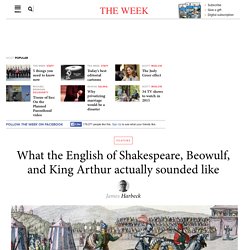
If this were a movie, no matter when we got out of the machine, we could walk up to people and start talking. It could be medieval times or the age of King Arthur's round table, and they'd just say, "Who art thou, varlet? " and we'd reply with something like, "We, uh, would-eth like-eth some beer-eth," and we'd all party. Yeah, no. I mean, of course they have to do that in movies, because we need to understand them. Shakespearean England First stop: the early 1600s. James Harbeck What Americans will sound like in 2050. Viking Sword Weaponry. Secrets of the Viking Sword PBS Airdate: October 10, 2012.

A Better 'Beowulf' Nova's SECRETS OF THE VIKING SWORD to Premiere 10/10. Viking Swords. Viking Age Arms and ArmorViking Swords More than anything else, the sword was the mark of a warrior in the Viking age.

They were difficult to make, and therefore rare and expensive. The author of Fóstbræðra saga wrote in chapter 3 that in saga-age Iceland, very few men were armed with swords. Howard Hanson: Symphony No. 3/Elegy/The Lament for Beowulf - Howard Hanson. HANSON Lament for Beowulf for chorus & orchestra Op 25. Beowulf in Old English (Prologue) Beowulf (modern English translation) by Anonymous.
Campbell's 'Hero's Journey' Monomyth. Disciplines > Storytelling > Plots > Campbell's 'Hero's Journey' Monomyth Separation | Initiation | Return | See also Joseph Campbell defined a classic sequence of actions that are found in many stories.

It is also known as the Monomyth, a term Campbell coined from James Joyce's Finnigan's Wake. I. Separation / departure. The Hero's Journey. Beowulf: The Curse. Beowulf Text, Summaries, & Translations. Beowulf Lego. Minecraft Beowulf Movie trailer. Beowulf: Minecraft Edition. Old English / Anglo-Saxon. Old English was the West Germanic language spoken in the area now known as England between the 5th and 11th centuries.
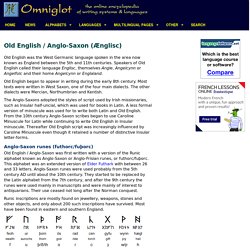
Speakers of Old English called their language Englisc, themselves Angle, Angelcynn or Angelfolc and their home Angelcynn or Englaland. Old English began to appear in writing during the early 8th century. Beowulf for Beginners - contents. Christian Elements in Beowulf. Museum: Anglo-Saxon Discovery - Daily Life. Life in Anglo-Saxon England. 1.

Introduction The Anglo-Saxon period lasted for some six centuries, from the arrival of Germanic invaders from the continent during the early fifth century AD to the Norman Conquest of 1066. This was a time of immense political and social upheaval which saw major changes in almost all aspects of everyday life. The early pagan settlers lived mainly by farming (see Unit 9, Farming), and formed a number of separate — and warring — kingdoms. By around 700 AD, there appears to have been a ‘Heptarchy’ of seven kingdoms (Northumbria, Mercia, East Anglia, Wessex, Essex, Sussex and Kent), while the main four in the ninth century were Northumbria, Mercia, East Anglia and Wessex. 2. Anglo-Saxon kings were prolific legislators, and a number of law-codes survive from the seventh to eleventh centuries. 3. 4.
A substantial literature survives from Anglo-Saxon England in both Latin and Old English. Other original writings in Old English include sermons, saints’ lives and wills. 5. 6. 7. Primary History - Anglo-Saxons - Anglo-Saxon life. Anglorum - A Brief History of Anglo-Saxon England. Primary History - Anglo-Saxons. Resources for the Study of Beowulf. Search websites about Beowulf:
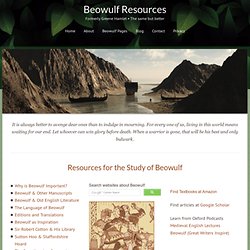
Scops. Because the scop was the product of a preliterate society, our records of his origins are imprecise.
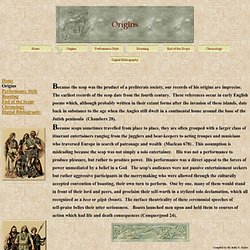
The earliest records of the scop date from the fourth century. These references occur in early English poems which, although probably written in their extant forms after the invasion of these islands, date back in substance to the age when the Angles still dwelt in a continental home around the base of the Jutish peninsula (Chambers 28).Because scops sometimes travelled from place to place, they are often grouped with a larger class of itinerant entertainers ranging from the jugglers and bear-keepers to acting troupes and musicians who traversed Europe in search of patronage and wealth (Maclean 678) . This assumption is misleading because the scop was not simply a solo entertainer. His was not a performance to produce pleasure, but rather to produce power. Scops' Boasting. The text of Beowulf describes the scop portrayed in that poem as being gilphladen, or "boast laden".
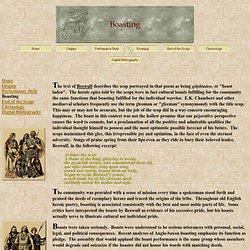
The heroic epics told by the scops were in fact cultural boasts fulfilling for the community the same functions that boasting fulfilled for the individual warrior. E.K. Chambers and other mediaeval scholars frequently use the term gleoman or "gleeman" synonymously with the title scop. How did English evolve? - Kate Gardoqui. This is a great story. But really, I made it sound way more simple than it really is. You probably have some questions already, if you’re a critical sort of person. Like: Beowulf Prologue said in Old English. Beowulf OE Video. Intro Beowulf is the longest epic poem in Old English, the language spoken in Anglo-Saxon England before the Norman Conquest. It tells the breathtaking story of a struggle between the hero, Beowulf, and a bloodthirsty monster called Grendel. Poems of this kind would often have been recited from memory by a court minstrel, or scop, to the accompaniment of a harp.
Beowulf - "Opening Lines" Benjamin Bagby's Beowulf. Excerpt from Scene 6: Beowulf and Grendel (lines 665-853) At this point in the story, Beowulf's arrival at the Danish King Hrothgar's court has been celebrated with a big feast, and as night approaches the Danes leave the haunted drinking hall to sleep elsewhere. They know that Grendel, the monster, will come to attack the hall in the night.
Beowulf and his men are left alone inside. The hero removes his weapons and armor and boasts that he will defeat Grendel with his bare hands. The men lie down to sleep; all except Beowulf are sure they will not survive the night. Eastern Europe and Scandinavia, 8000–2000 B.C. Encompasses present-day Belarus, Denmark, Estonia, Finland, Iceland, Latvia, Lithuania, Norway, western Russia, Sweden, and Ukraine The peoples of eastern Europe and Scandinavia gradually developed agriculture and pottery, the two technologies that define Neolithic culture elsewhere.
Although these developments are conventionally linked with the growth of settled village life, the inhabitants of Scandinavia and eastern Europe seem to have retained seasonal dwellings and a hunter's way of life even after they became successful part-time farmers. ca. 7500 B.C.The manufacture of microliths, small and carefully shaped stone elements of larger tools, becomes widespread in Scandinavia.
Beowulf Animated 1998 Part 1/6. Ancient Monsters. Numerous documents from antiquity tell of monstrous people living at the edge of the known world. In the first century A.D., Pliny the Elder described extraordinary races of humans living in India and Ethiopia: these included mouthless hairy creatures called Astomi, who had no need of food or drink; men with dog’s heads; and one-legged creatures who could hop at incredible speed and use their giant feet as umbrellas to protect them from the sun. Pliny was himself repeating ancient authorities, and his account of these marvellous races was in turn influential throughout the Middle Ages, during which antique monster lore became part of a Christian framework. For Christians, the monstrous races tested not only their credulity, but also their ethics.
Monstrous illustrations Interest in monstrous races endured through the Middle Ages. Demons in Christianity Demonising difference Bestiaries The natural world was also interpreted as the expression of a moral system. Illuminated monsters. An Exploration of Modern Monsters.